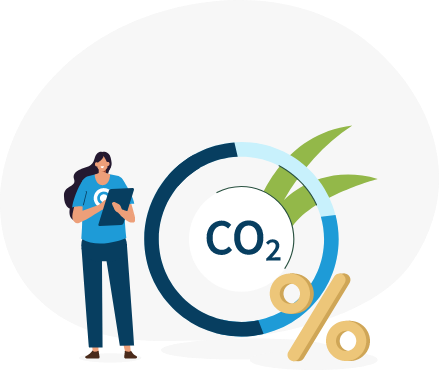
Corporate carbon footprint is an indicator that measures the environmental impact of an organization's activities. Calculating carbon footprint allows organizations to set targets for combating climate change and take measures to achieve those targets.
The corporate carbon footprint consultancy service process helps organizations to calculate, reduce, and report their carbon footprints, contributing to their organizations' goals of combating climate change and achieving sustainability goals.
As part of the service, corporate carbon footprint training is provided to company officials, the company's system boundaries are determined, and a Greenhouse Gas Inventory is created during the data collection process.
Our consultancy services include the following, in order to help organizations calculate, reduce, and report their carbon footprints in accordance with ISO 14064-1:2018 and the GHG Protocol:
- Corporate carbon footprint training
- System boundary definition,
- Greenhouse gas inventory definition,
- Carbon footprint calculation and reporting,
- Corporate carbon footprint procedure development.
Carbon offsetting is the process of compensating for a person or organization's carbon emissions by reducing or eliminating carbon emissions elsewhere.
Our carbon offsetting services cover the following organizations:
- Organizations that aim to be carbon neutral
- Organizations that request the elimination of greenhouse gas emissions from their company events
- Organizations that request that physical / online summits and conferences be organized as carbon neutral
To offset the greenhouse gas emissions of an organization or event, the carbon footprint must first be calculated. In this process, the carbon footprint of the company or event is calculated using the QuickCarbon software. The carbon footprint is offset with an equivalent amount of carbon credits, and an internationally valid Gold Standard / VCS / i-REC certificate is delivered.


Water footprint is an indicator that measures the impact of an organization's activities on water resources. Water footprint consultancy services help organizations to calculate, reduce, and report their water footprints. These services can help organizations to use water resources more efficiently and reduce their environmental impact.
As part of water footprint consultancy services, meetings are held with company officials after providing Water Footprint training. The data collection process is managed by creating a water flow diagram, water inventory list, and material inventory for the company.
In water footprint consultancy, the water inventory used by the company is examined using a gate-to-gate approach in accordance with the ISO 14046 standard, and the scope of the service is as follows:
- Water footprint training,
- Water footprint assessment,
- Data collection,
- Water footprint calculation and reporting.
The Carbon Border Adjustment Mechanism (CBAM) is a mechanism designed to help the European Union (EU) achieve its emissions reduction targets by imposing a carbon tax on imported carbon-intensive goods.
The CBAM was initially implemented for six different sectors: iron and steel, aluminum, cement, fertilizers, electricity, and hydrogen. The transition period began in October 2023, and the mechanism will be fully implemented in 2026.
To help companies comply with the CBAM, consulting and support services are available. These services provide companies with information about the CBAM's definition, scope, implementation dates, and steps to take to comply. In addition, support is provided for the preparation of necessary documents, software, and infrastructure to comply with the CBAM.
In conclusion, the CBAM is an important part of the EU's efforts to combat climate change. Companies can reduce the costs associated with this mechanism and increase their competitiveness by taking advantage of consulting and support services to comply with the CBAM. This helps companies complete the CBAM compliance process more efficiently and smoothly.




